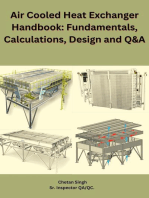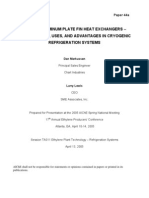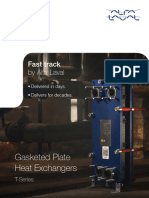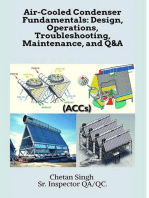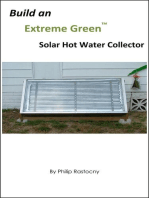Selecting A Thermal Fluid Heater Ebook PDF
Selecting A Thermal Fluid Heater Ebook PDF
Uploaded by
PierluigiBusettoCopyright:
Available Formats
Selecting A Thermal Fluid Heater Ebook PDF
Selecting A Thermal Fluid Heater Ebook PDF
Uploaded by
PierluigiBusettoOriginal Title
Copyright
Available Formats
Share this document
Did you find this document useful?
Is this content inappropriate?
Copyright:
Available Formats
Selecting A Thermal Fluid Heater Ebook PDF
Selecting A Thermal Fluid Heater Ebook PDF
Uploaded by
PierluigiBusettoCopyright:
Available Formats
Selecting a Thermal Fluid Heater
There are many heater manufacturers out there, and what can seem like an endless array of heater design options. Each of
these myriad designs was conceived with a particular application, environment, or budget in mind. When selecting a thermal
fluid heater, one must first understand the application, installation requirements and space restrictions. Let’s review a few
important factors to consider when comparing heater types and heater options.
Cost is always a factor for any purchase; however the true cost of
a heater is more complex than just the initial purchase price. The When choosing a thermal fluid
tradeoff between capital costs, operating cost, and long term
heater, one must first understand
maintenance costs must be considered in a proper evaluation. A
well designed and efficient engineered heating system may cost you
the application, installation
more initially than an ‘off-the-shelf’ heater or a heater with a lower requirements and space restrictions.
efficiency, but the less expensive options can become far more
expensive than you think. Once operating costs such as fuel costs, By the Process Engineering Group, Sigma Thermal
thermal fluid replacement, parts and maintenance begin to
accumulate over the first years of use, your initial savings may
not seem so significant.
Fuel efficiency requirements vary depending on fuel type, fuel
availability, application, run time, etc… A simple process requiring
low supply temperatures and an inexpensive thermal fluid may not
demand a customized highly efficient system, in which case a less
expensive heater option may be ideal. In direct contrast, a more
complex or demanding application requiring high temperatures
and a more expensive fluid will certainly see the benefits of a
properly designed engineered heating system. The difference in
cost between a system designed specifically for an application with
higher efficiencies, higher heating temperatures, and /or heavy duty
operation can typically be made up in short payback periods when
looking at the total operating costs of the equipment.
Note: Pay close attention to the method of fuel efficiency calculation
used by different vendors. These numbers can be skewed based on
the chosen method of calculation, and seemingly small differences
in efficiency can actually represent large differences in operating cost.
Compare carefully and don’t be afraid to ask your potential vendors to
The single helical coil is simple to design and fabricate, and it can
explain their efficiency claims, support their design calculations, and be built in horizontal orvertical configurations.
guarantee the stated efficiency at your operating conditions.
4875 Deen Road, Marietta, GA 30066 P 770-427-5770 F 678-254-1762 www.sigmathermal.com sales@sigmathermal.com 2
Design Parameters to Consider
Surface area of the heater coil (heat transfer surface) is crucial. A generous surface area, whether the heater is fired or
electric, is the starting point for a sound heater design. Inadequate surface area in your heater coil or heating element will
limit your efficiency and lead to a higher film temperature. This ultimately means thermally degrading your expensive heat
transfer fluid. Running poor quality oil in your system will shorten coil life, coke heating elements and decreased heater
efficiency over time. Of course the primary benefit to a reduced coil or element surface is less cost. Be sure to carefully
consider coil and element surface area and relative heat flux rates when comparing heater options. This is an important area
where initial savings can result in massive costs down the road.
Fluid velocity and pressure drop are inherently related and vital in engineering an appropriate heater for any application.
In general, a higher fluid velocity means better heat transfer and lower film temperatures. This comes with a tradeoff though,
as pressure drop increases with fluid velocity. Higher pressure drop means more pump horsepower, which indirectly
increases your operating costs due to the increase in power consumption. You can have one heater design that has very low
pressure drop resulting in low fluid velocities that yield higher film temperatures, while another heater design is masking a
low coil surface area with extremely high velocities resulting in reasonable film temperatures, but very high pressure drop.
This design parameter is just one piece to the puzzle. In order to compare
more appropriately, be sure to obtain fluid velocities, pressure drops,
film temperatures, and heat flux rates. Be sure to discuss and
understand what pressure drops your heat user system may
allow in addition to what minimum and maximum flows are
safe for your heater.
Combustion chamber size and flame impingement are also
critical to heater design. The biggest potential for damaging
your coil and your fluid lies within the radiant zone of your
heater. A well sized combustion chamber will ensure proper
heat release within the radiant zone, but it also ensures that
there is no potential for flame impingement on the coil.
Flame impingement causes local hot spots on a heater coil
which result in localized fluid degradation and potentially
even coil damage. Ask your potential suppliers to discuss their
combustion chamber size as it relates to the burner flame size
and its proximity to the heater coil.
The design of the double helical coil thermal fluid heater
incorporates two concentric helical coils, one inside of the other.
This allows for three passes of flue gases.
4875 Deen Road, Marietta, GA 30066 P 770-427-5770 F 678-254-1762 www.sigmathermal.com sales@sigmathermal.com 3
Heater Design Types
Armed with a basic understanding of what is important to your application and/or facility, you now need to select the right heater
design. Unfortunately it is not always obvious to the casual buyer which type is best for their application. Each manufacturer will
tout the merits of their specific designs, and you need to be able to understand how those differences relate to your needs. We
will try to summarize several types and discuss the pros and cons of each relative to performance, cost, and footprint.
Single Helical Coil Thermal Fluid Heater
• The single coil is a simple cost effective design. Utilizing a single helical coil, this design
allows for two passes of flue gas along the heat transfer surface. The single helical coil is
very simple to design and fabricate, and can be built in horizontal or vertical configurations
• Generally speaking, this heater style will have lower efficiencies than other heater with
more available surface area. In some cases a manufacturer will require an additional waste
heat recovery unit to achieve the efficiencies capable in other base heater designs.
• High exhaust temperatures at the first turn require internal insulation to protect the heater
shell from extreme temperatures. This internal insulation is subject to wear and could need
to be replaced over time. Single Helical Coil Heater
Double Helical Coil Thermal Fluid Heater
• This design incorporates two concentric helical coils, one inside of the other. This
allows for three passes of flue gasses, and this additional pass of flue gas (compared with
a single coil heater) allows for additional heat transfer surface for a comparably sized unit.
The additional surface area typically makes these heaters more efficient than a
comparable single coil design.
• The double helical coil is typically more expensive than a single helical coil design. It
can be configured in either a horizontal or vertical arrangement.
• A dual helical coil allows for a large heat duty in a small overall footprint. If size is an
issue for your facility this may very well be a deciding factor. Larger duty requirements
may dictate that a dual helical design be used, as it is difficult to build a shippable single
coil unit above 25MM Btu/hr. Double Helical Coil Heater
• The flue gasses are relatively cool when first contacting the heater shell, eliminating the need for most internal shell
insulation. This minimizes long term insulation maintenance and/or replacement.
4875 Deen Road, Marietta, GA 30066 P 770-427-5770 F 678-254-1762 www.sigmathermal.com sales@sigmathermal.com 4
Heater Design Types (cont.)
Radiant-Convective Thermal Fluid Heater
• Worldwide, the traditional radiant-convective style heater is the most well-known and
commonly used style of direct fired heater. These heaters are physically larger than their
helical coil counterparts, utilizing both a bare tube radiant zone in combination with a
separate bare / finned convection zone.
• Radiant-convective style heaters are more complicated to design and build, and are
therefore typically more expensive than other heater types.
• A wide range of design capabilities allow for flexible performance and configuration
Cabin Style Radiant-Convective Heater
options. Efficiencies of a new heater can also vary from 70 – 90%, and footprints can be
small and tall with vertical-cylindrical heaters, or shorter and wide with cabin style heaters.
• Several manufactures have their own proprietary design for this radiant convective style of heater, but the most widely
accepted standard is API 560. API 560 heaters have been used for many years in the oil & gas industry to heat petroleum
streams in various stages of production. This specification is often applied to thermal fluid systems, which in almost all cases
is unnecessary. This specification is extremely conservative in nature, and is really only necessary when heating a non-
homogenous petrochemical stream with varying thermophysical properties. When applied to a thermal fluid, which is an
engineered fluid with well-known and homogenous properties, it adds unnecessary size, cost and complexity.
4875 Deen Road, Marietta, GA 30066 P 770-427-5770 F 678-254-1762 www.sigmathermal.com sales@sigmathermal.com 5
Heater Design Types (cont.)
In-Line Electric Circulation Heater
• This design uses an electric flanged immersion heater with a shell to allow flow
directly over the heating elements. Since there is no combustion, virtually 100% of the
energy goes into the media being heated.
• Can be mounted in horizontal or vertical position for space savings.
• Typically a smaller footprint because of smaller duties. Mounting options include
saddles, skirts, legs or mounting blocks.
• Vessel can be ASME Section VIII Div 1. Certified and “U” stamped.
• Simple design and lower maintenance that fired heaters.
• Can be installed in hazardous areas
For questions about this article or its contents, contact Sigma Thermal at sales@sigmathermal.com or 770-427-5770.
4875 Deen Road, Marietta, GA 30066 P 770-427-5770 F 678-254-1762 www.sigmathermal.com sales@sigmathermal.com 6
You might also like
- Air Cooled Heat Exchanger Handbook: Fundamentals, Calculations, Design and Q&AFrom EverandAir Cooled Heat Exchanger Handbook: Fundamentals, Calculations, Design and Q&ANo ratings yet
- Boiler Operation Engineer Exam, Interview Q&A, Terminology, and Boiler OverviewFrom EverandBoiler Operation Engineer Exam, Interview Q&A, Terminology, and Boiler OverviewRating: 4.5 out of 5 stars4.5/5 (3)
- Burnham Wetback Vs DrybackDocument2 pagesBurnham Wetback Vs Drybacksandi1111No ratings yet
- All Heat Exchangers Are Not EqualDocument5 pagesAll Heat Exchangers Are Not EqualGesar GesarNo ratings yet
- Heat Exchanger Design: Table of ContentDocument18 pagesHeat Exchanger Design: Table of ContenthellopaNo ratings yet
- 2008 Commercial Boiler EfficiencydeterminetestDocument11 pages2008 Commercial Boiler EfficiencydeterminetestMakhdum Muhardiana PutraNo ratings yet
- Ganapathy PDFDocument90 pagesGanapathy PDFpinenamuNo ratings yet
- Tank Heating DiscussionsDocument26 pagesTank Heating DiscussionsTHERMAX007No ratings yet
- Cast Heater White PaperDocument3 pagesCast Heater White Paperssmith2007No ratings yet
- Brazed Aluminium Plate Fin Heat Exchangers-Construction, Uses Advantages in Cryogenic Refrigeration SystemsDocument31 pagesBrazed Aluminium Plate Fin Heat Exchangers-Construction, Uses Advantages in Cryogenic Refrigeration SystemsHitesh Panchal100% (2)
- BoilerEfficiency PDFDocument7 pagesBoilerEfficiency PDFMurugan VeluNo ratings yet
- District Cooling Systems (Energy Engineering)Document12 pagesDistrict Cooling Systems (Energy Engineering)Aouina ChokriNo ratings yet
- Chiller BasicsDocument7 pagesChiller BasicsQOBITNo ratings yet
- Proposal ScriptDocument9 pagesProposal ScriptFionaNo ratings yet
- Immersion Heaters-Selection & Implementation-Article From Chemical Engineering January-2006Document5 pagesImmersion Heaters-Selection & Implementation-Article From Chemical Engineering January-2006John UrdanetaNo ratings yet
- Catalog, Steam Hot Water Unit Heaters MODINEDocument28 pagesCatalog, Steam Hot Water Unit Heaters MODINECab_de_?No ratings yet
- Keeping Kiln Shell Temperatures Under ControlDocument5 pagesKeeping Kiln Shell Temperatures Under ControlAlsadig AliNo ratings yet
- Criteria For Selecting Heat ExchangerDocument7 pagesCriteria For Selecting Heat ExchangerKashaf TehreemNo ratings yet
- Waste Heat Recovery Considering Environmental FactorsDocument7 pagesWaste Heat Recovery Considering Environmental FactorsrvnesariNo ratings yet
- Oil HeatersDocument48 pagesOil HeaterstotalandromedaNo ratings yet
- Boiler Project Fundamentals: Back To BasicsDocument7 pagesBoiler Project Fundamentals: Back To BasicsChemical.Ali100% (1)
- Boiler Project FundamentalsDocument7 pagesBoiler Project FundamentalsAlejandro AlvarengaNo ratings yet
- What Are Double Pipe Heat Exchangers and Their Working PrinciplesDocument8 pagesWhat Are Double Pipe Heat Exchangers and Their Working PrinciplesAngel RatuNo ratings yet
- A Review of Gas-Gas Heat Recovery SystemsDocument39 pagesA Review of Gas-Gas Heat Recovery SystemspinenamuNo ratings yet
- Gea Red Heat Pumps North America 295686Document20 pagesGea Red Heat Pumps North America 295686wipiriNo ratings yet
- Fired HeatersDocument20 pagesFired HeatersCal100% (5)
- Fired HeatersDocument19 pagesFired HeatersCelestine OzokechiNo ratings yet
- Heat Recovery From Exhaust GasesDocument6 pagesHeat Recovery From Exhaust GasesnaveenNo ratings yet
- Understanding Power Losses in Vacuum FurnacesDocument16 pagesUnderstanding Power Losses in Vacuum FurnacesHa yesmineNo ratings yet
- Heating Helper For Steam Boiler and Full CalculationDocument113 pagesHeating Helper For Steam Boiler and Full Calculation185412100% (1)
- Hopper Heating Design GuideDocument4 pagesHopper Heating Design GuideBadukwangNo ratings yet
- Specifying Shell and Tube Heat ExchangersDocument10 pagesSpecifying Shell and Tube Heat ExchangersMicheal BrooksNo ratings yet
- Alfa Laval Gphe Catalog 2022Document20 pagesAlfa Laval Gphe Catalog 2022JUAN ANTONIO HERNANDEZ SOSANo ratings yet
- Heat Pumps - Your Questions AnsweredDocument13 pagesHeat Pumps - Your Questions Answeredmwood1scNo ratings yet
- Absorption Chillers 07Document52 pagesAbsorption Chillers 07Sujadi Cherbond100% (1)
- Air Conditioning 101 - Basics, Working Principle and Sizing Calculations - Engineering360Document7 pagesAir Conditioning 101 - Basics, Working Principle and Sizing Calculations - Engineering360rollrams100% (1)
- Summary Plate Heat ExchangerDocument4 pagesSummary Plate Heat ExchangerNice OrioleNo ratings yet
- ABMA Boiler Types For Steam ApplicationsDocument27 pagesABMA Boiler Types For Steam Applicationshasrunizra100% (1)
- Understand Why Furnace Size Varies For Gas, Oil and Coal FiringDocument4 pagesUnderstand Why Furnace Size Varies For Gas, Oil and Coal FiringSanjiv ChNo ratings yet
- Rethink Specifications For Fired HeatersDocument7 pagesRethink Specifications For Fired HeatersAhmed SeliemNo ratings yet
- Radiator Design and OptimizationDocument12 pagesRadiator Design and Optimizationspandan shahNo ratings yet
- OGF 2018 07 Static Equipment Understanding Heat ExchangersDocument15 pagesOGF 2018 07 Static Equipment Understanding Heat Exchangersmostafa morshedyNo ratings yet
- Cold Box - Advantages To Brazed Fin ExchangersDocument13 pagesCold Box - Advantages To Brazed Fin ExchangersEdison Choi100% (1)
- Advantages of Brazed Heat Exchangers in The Gas Processing IndustryDocument13 pagesAdvantages of Brazed Heat Exchangers in The Gas Processing IndustryWalter PasoliniNo ratings yet
- Trane Chiller Plant Admapn014en - 0105Document4 pagesTrane Chiller Plant Admapn014en - 0105a_salehiNo ratings yet
- Waste Heat RecoveryDocument20 pagesWaste Heat RecoveryAMIT PRAJAPATINo ratings yet
- Rama HotrunnerDocument43 pagesRama Hotrunner1keyvan1No ratings yet
- Immersion HeatersDocument5 pagesImmersion Heatersjuanper01No ratings yet
- Heat Pipe Heat ExchangerDocument20 pagesHeat Pipe Heat ExchangerrolwinNo ratings yet
- Engine Cooling Systems HP1425: Cooling System Theory, Design and Performance for Drag Racing,Road Racing,Circle Track, Street Rods, Musclecars, Imports, OEM Cars, Trucks, RVs and Tow VehiclesFrom EverandEngine Cooling Systems HP1425: Cooling System Theory, Design and Performance for Drag Racing,Road Racing,Circle Track, Street Rods, Musclecars, Imports, OEM Cars, Trucks, RVs and Tow VehiclesNo ratings yet
- Making Your Home More Energy Efficient: A Practical Guide to Saving Your Money and Our PlanetFrom EverandMaking Your Home More Energy Efficient: A Practical Guide to Saving Your Money and Our PlanetNo ratings yet
- High-Performance Automotive Cooling SystemsFrom EverandHigh-Performance Automotive Cooling SystemsRating: 4.5 out of 5 stars4.5/5 (2)
- Air-Cooled Condenser Fundamentals: Design, Operations, Troubleshooting, Maintenance, and Q&AFrom EverandAir-Cooled Condenser Fundamentals: Design, Operations, Troubleshooting, Maintenance, and Q&ARating: 5 out of 5 stars5/5 (1)
- Process Engineering: Facts, Fiction and FablesFrom EverandProcess Engineering: Facts, Fiction and FablesRating: 3 out of 5 stars3/5 (2)
- Hot Water Heater Installation and Repair: A Step-by-Step Guide to DIY Installation, Maintenance, and Troubleshooting for Homeowners: Homeowner Plumbing Help, #4From EverandHot Water Heater Installation and Repair: A Step-by-Step Guide to DIY Installation, Maintenance, and Troubleshooting for Homeowners: Homeowner Plumbing Help, #4No ratings yet
- Chimneys & Fireplaces: They Contribute to the Health Comfort and Happiness of the Farm Family - How to Build ThemFrom EverandChimneys & Fireplaces: They Contribute to the Health Comfort and Happiness of the Farm Family - How to Build ThemNo ratings yet
- The Home Owner's Guide to HVAC: The Envelope and Green TechnologiesFrom EverandThe Home Owner's Guide to HVAC: The Envelope and Green TechnologiesRating: 4 out of 5 stars4/5 (1)
- Textbook of Urgent Care Management: Chapter 5, Business Formation and Entity StructuringFrom EverandTextbook of Urgent Care Management: Chapter 5, Business Formation and Entity StructuringNo ratings yet
- How To Batch Convert Your IDWDocument6 pagesHow To Batch Convert Your IDWPierluigiBusettoNo ratings yet
- Optimum Design of Pressure Vessel Subjected To Autofrettage ProcessDocument6 pagesOptimum Design of Pressure Vessel Subjected To Autofrettage ProcessPierluigiBusettoNo ratings yet
- Heat Balance Calculation Sheet - Part ADocument1 pageHeat Balance Calculation Sheet - Part APierluigiBusettoNo ratings yet
- A Complete Design of Ship Propellers Using The New Computer SystemDocument6 pagesA Complete Design of Ship Propellers Using The New Computer SystemPierluigiBusettoNo ratings yet
- Pad Eyes PDFDocument1 pagePad Eyes PDFPierluigiBusettoNo ratings yet
- Cargo Oil Heating Requirements For An FSO Vessel Conversion PDFDocument11 pagesCargo Oil Heating Requirements For An FSO Vessel Conversion PDFPierluigiBusettoNo ratings yet
- Overview Heat Transfer Fluid - Gilles Flamant PDFDocument51 pagesOverview Heat Transfer Fluid - Gilles Flamant PDFPierluigiBusettoNo ratings yet
- Overview Heat Transfer Fluid - Gilles Flamant PDFDocument51 pagesOverview Heat Transfer Fluid - Gilles Flamant PDFPierluigiBusettoNo ratings yet
- Data Sheet - HFO Heavy Fuel OilDocument9 pagesData Sheet - HFO Heavy Fuel OilPierluigiBusettoNo ratings yet
- SimplificationDocument3 pagesSimplificationrabi patraNo ratings yet
- Paper # 153 - The Appropriateness of The Transfer Size in Ag and Sag Mill Circuit DesignDocument13 pagesPaper # 153 - The Appropriateness of The Transfer Size in Ag and Sag Mill Circuit Designcuberbill1980No ratings yet
- Transcript ApplicationDocument2 pagesTranscript ApplicationSwetha ReddyNo ratings yet
- Functional English Beginners II (ENG 108)Document3 pagesFunctional English Beginners II (ENG 108)REHANRAJ100% (1)
- 1 07 Heavy Metals Limit Test 46Document2 pages1 07 Heavy Metals Limit Test 46student_bbNo ratings yet
- Research PaperDocument20 pagesResearch PaperRaja Sufyan MinhasNo ratings yet
- Research Synopsis FormatDocument2 pagesResearch Synopsis FormatLakshmi Lak100% (1)
- MinorDocument3 pagesMinorEkta BitzNo ratings yet
- BST PQMS2Document10 pagesBST PQMS2jaiNo ratings yet
- Lab Mannual DcomDocument32 pagesLab Mannual DcomRam KapurNo ratings yet
- Literature ReviewDocument18 pagesLiterature Reviewobrowser12No ratings yet
- Assessment Book pp2Document41 pagesAssessment Book pp2Paul OnyangoNo ratings yet
- Normative Ethics-Ethics Final ExamDocument7 pagesNormative Ethics-Ethics Final ExamCAIRAH PAYUSANNo ratings yet
- InformationM SDocument34 pagesInformationM SsmaniveeNo ratings yet
- MyocarditisDocument29 pagesMyocarditishastonniiNo ratings yet
- Types of Nouns: English, Grammar ReviewDocument14 pagesTypes of Nouns: English, Grammar ReviewIrish Bianca Usob Luna100% (1)
- Hacktiv8 2022 Impact ReportDocument41 pagesHacktiv8 2022 Impact Reportlewi251202No ratings yet
- Cusps: Avneesh Ku 29-Jan-1972 11:10:00 Am Agra 78:5:0 E, 27:10:0 N Tzone: 5.5 KP (Original) Ayanamsha 23:22:23Document2 pagesCusps: Avneesh Ku 29-Jan-1972 11:10:00 Am Agra 78:5:0 E, 27:10:0 N Tzone: 5.5 KP (Original) Ayanamsha 23:22:23Anonymous AQPr7tkSBNo ratings yet
- 1566296779769AURUS MEMOIRS - CHRIST Book of MemoriesDocument100 pages1566296779769AURUS MEMOIRS - CHRIST Book of MemoriesravitNo ratings yet
- POST-COLONIAL - The Movie in Their Minds - The Asian Diaspora in America (COMPARATIVE ANALYSIS)Document17 pagesPOST-COLONIAL - The Movie in Their Minds - The Asian Diaspora in America (COMPARATIVE ANALYSIS)Jonathan AysonNo ratings yet
- Old Lithuanian Songs (Martin Lings) PDFDocument9 pagesOld Lithuanian Songs (Martin Lings) PDFIsraelNo ratings yet
- Omer Shujat Bhatti, Muhammad Asad Ghufran, Atta Ullah ShahDocument20 pagesOmer Shujat Bhatti, Muhammad Asad Ghufran, Atta Ullah Shahrithy khouyNo ratings yet
- Under The Guidance Of: A Summer Training Report ONDocument50 pagesUnder The Guidance Of: A Summer Training Report ONAnil BatraNo ratings yet
- Learning From The Land: Indigenous Land Based Pedagogy and DecolonizationDocument15 pagesLearning From The Land: Indigenous Land Based Pedagogy and DecolonizationleoNo ratings yet
- Magika No Kenshi To Shoukan Maou - Volume 12Document362 pagesMagika No Kenshi To Shoukan Maou - Volume 12Michele RogersNo ratings yet
- Understanding Words Through Context Clues - by Definition and by ExampleDocument6 pagesUnderstanding Words Through Context Clues - by Definition and by ExampleREVEN VILLARTANo ratings yet
- LogDocument23 pagesLogauliaseffyNo ratings yet
- EPC Company ProfileDocument5 pagesEPC Company Profilehasan.mehedi0212No ratings yet
- Lesson 3-Adaptations in Animals KeywordsDocument3 pagesLesson 3-Adaptations in Animals KeywordsKristin Denis CorveraNo ratings yet
- Gastrostomy Feeding ProcedureDocument5 pagesGastrostomy Feeding ProcedureRohini RaiNo ratings yet
